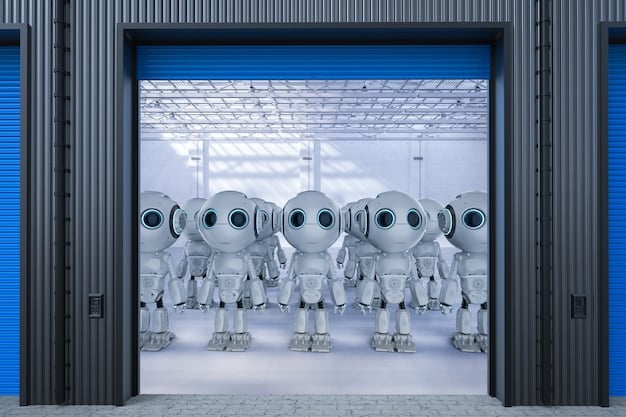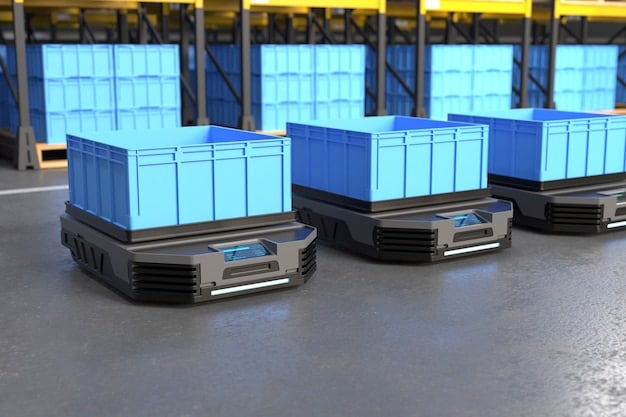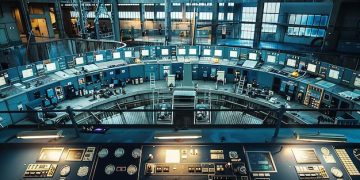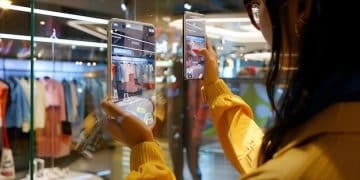US Robotics: Latest Advancements in Manufacturing & Healthcare

The latest advancements in US robotics are rapidly transforming key sectors like manufacturing and healthcare, driving unprecedented efficiency, precision, and innovation through sophisticated AI integration, enhanced human-robot collaboration, and expanding capabilities.
The landscape of technological innovation is continuously reshaping our world, and few fields exemplify this evolution quite like robotics. Specifically, the latest advancements in US robotics: from manufacturing to healthcare, represent a critical frontier where cutting-edge research meets practical application, promising to revolutionize industries and improve daily lives. This exploration delves into the significant strides made, examining how these sophisticated machines are not only optimizing processes but also redefining the boundaries of what is possible in various sectors.
Revolutionizing Manufacturing with Advanced Robotics
The manufacturing sector has long been an early adopter of robotic technologies, but the current wave of advancements in the US is pushing boundaries beyond mere automation. Today’s industrial robots are smarter, more agile, and capable of performing complex tasks with unprecedented precision. This evolution is vital for maintaining global competitiveness and fostering domestic innovation.
Collaborative Robots (Cobots) Enhancing Human-Robot Teams
One of the most significant shifts in manufacturing robotics is the rise of collaborative robots, or cobots. Unlike traditional industrial robots that operate in cages due to safety concerns, cobots are designed to work alongside humans. They are equipped with advanced sensors and safety features that allow them to detect and react to human presence, preventing collisions and enabling seamless interaction.
This close collaboration opens doors to new efficiencies:
- Increased Productivity: Cobots can handle repetitive, strenuous, or dangerous tasks, freeing human workers to focus on more complex, value-added activities that require cognitive skills and adaptability.
- Enhanced Flexibility: Their ease of programming and reconfigurability make them ideal for high-mix, low-volume production environments, allowing manufacturers to quickly adapt to changing market demands.
- Improved Ergonomics and Safety: By taking over physically demanding jobs, cobots reduce the risk of injury and fatigue for human workers, leading to a safer and more comfortable work environment.
AI and Machine Learning Driving Smart Manufacturing
The integration of Artificial Intelligence (AI) and Machine Learning (ML) is transforming manufacturing robots into intelligent systems. These robots can learn from data, adapt to new situations, and even make autonomous decisions. This leads to more efficient production lines, reduced waste, and higher quality products. For example, AI-powered vision systems allow robots to inspect products with incredible accuracy, identifying defects that human eyes might miss. Predictive maintenance, enabled by ML algorithms analyzing robot performance data, allows companies to anticipate potential equipment failures and perform maintenance proactively, minimizing downtime and saving costs. The ability of robots to communicate with each other and with central control systems creates highly synchronized and optimized production workflows, leading to significant gains in overall equipment effectiveness.
The ability for robots to learn and refine their movements based on real-time feedback is also critical in tasks requiring extreme precision, such as micro-assembly or delicate material handling. This continuous learning minimizes errors and improves consistency throughout the manufacturing process.
Transforming Healthcare: Robotics in Medical Applications
Beyond the factory floor, US robotics is making profound impacts in the healthcare sector, addressing critical challenges from surgical precision to patient care and rehabilitation. The ethical considerations are paramount, but the potential to save lives and improve quality of life is undeniable.
Surgical Robotics: Precision and Minimally Invasive Procedures
Surgical robots, such as the widely recognized da Vinci Surgical System, have revolutionized various surgical procedures. These systems allow surgeons to perform complex operations with enhanced precision, control, and dexterity, often through smaller incisions.
The benefits include:
- Reduced Trauma: Minimally invasive surgery leads to less pain, smaller scars, and faster recovery times for patients compared to traditional open surgery.
- Enhanced Visualization: Robotic systems provide magnified, high-definition 3D views of the surgical site, giving surgeons unparalleled clarity.
- Greater Dexterity and Range of Motion: Robotic instruments can articulate in ways a human hand cannot, reaching difficult-to-access areas with tremor reduction.
These advancements are not replacing surgeons but augmenting their capabilities, allowing for more precise and safer interventions in fields like urology, gynecological surgery, and general surgery. This leads to better patient outcomes and a reduction in hospital stays, contributing to efficiency within the healthcare system.
Robotics in Patient Care and Rehabilitation
Robots are increasingly finding roles in direct patient care, supporting nurses and caregivers, and in rehabilitation therapies. Service robots can assist with tasks like delivering medication, food, or lab samples within hospitals, reducing the workload on human staff and allowing them to focus on more critical patient interactions.
In rehabilitation, robotic exoskeletons and therapy robots are transforming how patients recover from injuries or strokes. These devices provide repetitive, high-intensity training, helping patients regain mobility and strength more effectively. They can adapt to individual patient needs and track progress, offering personalized rehabilitation plans. Furthermore, social robots are being explored for their potential to provide companionship and support to elderly individuals or those with chronic conditions, helping them maintain independence and improve their mental well-being. The development of robotic prosthetics offers unparalleled levels of dexterity and sensory feedback, significantly enhancing the lives of amputees by restoring function in ways previously unimaginable. These are not just mechanical devices; they are often integrated with direct neural interfaces, allowing for a more natural and intuitive control.
Logistics and Supply Chain: The Automated Backbone
The seamless flow of goods, from raw materials to finished products and life-saving medical supplies, relies heavily on efficient logistics and supply chains. In the US, robotics is becoming the automated backbone of these critical operations, ensuring speed, accuracy, and resilience. This sector is witnessing rapid innovation as companies strive to meet increasing consumer demands and navigate complex global networks.

Autonomous Mobile Robots (AMRs) in Warehousing
Autonomous Mobile Robots (AMRs) represent a significant leap forward from traditional Automated Guided Vehicles (AGVs). Unlike AGVs, which follow fixed paths (e.g., magnetic strips), AMRs navigate dynamically using onboard sensors, cameras, and sophisticated mapping software.
Their impact on warehousing is profound:
- Optimized Workflows: AMRs can quickly adapt to changing layouts, obstacles, and priorities, ensuring goods are moved efficiently.
- Increased Throughput: By automating transportation tasks, AMRs reduce the time it takes to pick, sort, and move inventory, significantly boosting warehouse productivity.
- Reduced Labor Costs and Errors: They alleviate the need for human workers to perform physically demanding and repetitive transport roles, simultaneously minimizing human error in material handling.
These robots are not just moving items; they are integrated into complex warehouse management systems that orchestrate the entire flow of inventory, from receiving to dispatch. This integration ensures real-time visibility and highly optimized operations, which are crucial for e-commerce and just-in-time delivery models.
Drone Delivery and Last-Mile Automation
While still in nascent stages for widespread adoption, drone technology is steadily advancing in the US for specific logistics applications, particularly in last-mile delivery and inventory management. Drones offer the potential for rapid, on-demand deliveries, especially for time-sensitive items like medical supplies or critical components. In isolated or difficult-to-reach areas, drones can provide a unique solution, bypassing traditional infrastructure challenges. Beyond delivery, drones are increasingly used in large warehouses or distribution centers to perform aerial inventory checks, scanning barcodes rapidly and reducing the need for manual stock counts. This not only enhances accuracy but also significantly speeds up the inventory management process, allowing businesses to have a more real-time understanding of their stock levels.
The challenges largely revolve around regulatory approvals, air traffic management, and public acceptance, but the technological progress continues to be robust, indicating a future where drone delivery will be a more common sight. This innovation extends to ground-based autonomous delivery vehicles, which are being piloted in urban and suburban areas to address the challenges of last-mile logistics, promising faster and more cost-effective delivery solutions.
The Growing Human-Robot Collaboration Paradigm
As robotics technologies mature, the narrative is shifting from robots replacing humans to robots augmenting human capabilities. This human-robot collaboration (HRC) is a burgeoning field across various sectors in the US, promising enhanced productivity, safety, and job satisfaction. The synergy between human cognitive abilities and robotic precision is unlocking new potentials.
Designing for Interaction: Intuitive Interfaces and Safety
The success of HRC largely depends on the seamless and safe interaction between humans and robots. This requires significant advancements in user interfaces, making robots easier to program, monitor, and troubleshoot for non-expert users. Intuitive graphical interfaces, even gesture- or voice-controlled systems, are becoming more common.
Safety remains paramount. Advanced sensor arrays, including vision systems, force-torque sensors, and proximity sensors, enable robots to perceive their environment and react to human presence in real-time. This not only prevents accidents but also allows robots to adapt their movements to work collaboratively, for instance, by slowing down or pausing if a human enters their shared workspace. The development of ISO standards for collaborative robots is a testament to the industry’s commitment to ensuring a safe working environment.
Ethical Considerations and Workforce Development
The increasing integration of robots into human workspaces raises important ethical questions and necessitates proactive workforce development strategies. Concerns about job displacement are valid, but the focus is increasingly on job transformation, where new roles requiring different skills emerge. This requires investment in education and training programs to upskill and reskill the workforce. Ethical frameworks are being developed to address issues such as data privacy, accountability for robotic actions, and ensuring equitable access to these technologies. Policies that support a just transition for workers impacted by automation are crucial for widespread societal acceptance and beneficial integration. The goal is to leverage robotics to create more fulfilling and safer jobs, rather than simply eliminating them, by focusing on tasks where robots complement human strengths.
Robotics in Exploration and Hazardous Environments
Beyond the industrial floor and hospital corridors, US robotics is pushing the boundaries of exploration and operating in environments too dangerous or inaccessible for humans. From deep-sea trenches to outer space and disaster zones, these specialized robots are gathering invaluable data and performing critical tasks without risking human lives.
Space Exploration: Pushing the Cosmic Frontier
NASA, with its network of academic and industry partners, leads the world in developing robots for space exploration. Rovers like Perseverance and Curiosity on Mars are prime examples, traversing alien landscapes, collecting samples, and conducting scientific experiments autonomously. These robots are designed to withstand extreme conditions, operate with limited human intervention, and provide groundbreaking insights into the universe. Future missions envision robotic assistants working alongside human astronauts, performing routine maintenance, and even constructing habitats on other planets. The development of robotic arms for satellites and space stations is also critical for repairs and scientific endeavors, extending the lifespan and capabilities of orbital assets, proving essential for long-duration missions.
Disaster Response and Search & Rescue
In times of disaster, such as earthquakes, floods, or structural collapses, robots offer a lifeline for search and rescue operations. Small, agile robots can navigate unstable debris fields, assess structural integrity, and locate survivors in areas too dangerous for human rescuers. Drones equipped with thermal cameras and other sensors can quickly map affected areas, identify hot spots, or locate missing persons, providing critical intelligence to first responders. These robots minimize risk to human lives while maximizing the efficiency and effectiveness of humanitarian efforts in emergency situations. Furthermore, specialized robots are being developed to handle hazardous materials, clear unexploded ordnance, or assess damage in environments contaminated by chemical, biological, radiological, or nuclear agents, thereby safeguarding human emergency personnel.
The Road Ahead: Challenges and Future Outlook
The trajectory of US robotics is one of accelerating innovation, but it is not without its challenges. Addressing these obstacles will be crucial for realizing the full potential of these transformative technologies. The future promises even more sophisticated and integrated robotic systems, but careful planning and collaboration are essential to navigate ethical, economic, and technical hurdles.
Addressing Technical Hurdles and Integration Costs
Despite rapid advancements, significant technical hurdles remain. Improving robot dexterity for complex manipulation tasks, enhancing perception capabilities in dynamic and unstructured environments, and developing more sophisticated AI for truly autonomous decision-making are ongoing research areas. The cost of integrating robotics, particularly for small and medium-sized enterprises (SMEs), can be prohibitive. While robot prices are decreasing, the complexity of implementation, maintenance, and the need for skilled labor to manage these systems can be substantial. Developing more affordable, user-friendly, and interoperable robotic systems will be key to broader adoption. This includes fostering open-source initiatives and standardized communication protocols to lower integration barriers.
Ethical Frameworks and Regulatory Landscapes
As robots become more autonomous and integrated into daily life, developing robust ethical frameworks and clear regulatory landscapes becomes paramount. Issues such as job displacement, data privacy, accountability for robotic errors, and the potential for misuse of autonomous systems require thoughtful consideration and public dialogue. Policymakers face the challenge of creating regulations that foster innovation while ensuring safety, fairness, and societal benefit. This involves balancing economic growth with social responsibility, ensuring that the benefits of robotics are widely distributed and that potential negative impacts are mitigated proactively. The legal implications of robot autonomy, particularly concerning liability in case of accidents, are also a complex area that requires significant legislative attention and consensus-building as these technologies become more prevalent.
| Key Area | Brief Description |
|---|---|
| 🏭 Manufacturing | Cobots and AI are boosting efficiency, safety, and flexibility on factory floors, enabling human-robot collaboration for complex tasks. |
| 🏥 Healthcare | Robotics enhances surgical precision, assists in patient care, and drives innovations in rehabilitation and prosthetic development. |
| 📦 Logistics | AMRs revolutionize warehousing, and drones explore last-mile delivery, optimizing supply chain speed and accuracy. |
| 🤝 Human-Robot Collaboration | Focus on intuitive interfaces and safety protocols to enable seamless interaction, creating new roles and enhancing productivity. |
Frequently Asked Questions About US Robotics
▼
Cobots, or collaborative robots, are designed to work safely alongside human employees without the need for extensive safety caging. In US manufacturing, they are changing operations by enabling closer human-robot collaboration, improving productivity, enhancing workplace safety by taking over dangerous tasks, and offering greater flexibility for diverse production needs, fostering more agile production lines.
▼
In US healthcare, robots are employed in various capacities. Surgical robots enhance precision for minimally invasive procedures, leading to faster patient recovery. Service robots assist with tasks like medication delivery in hospitals, freeing up staff. Rehabilitation robots help patients regain mobility and strength, and robotic prosthetics offer advanced functional restoration for amputees, significantly improving patient outcomes and care delivery.
▼
AI and Machine Learning are vital for enabling robots to learn, adapt, and make autonomous decisions. They allow robots to perform complex tasks with greater accuracy, optimize processes based on real-time data, and predict maintenance needs. This intelligence is crucial for transitioning from rigid automation to more flexible, intelligent systems capable of handling dynamic environments and complex problem-solving in manufacturing and beyond.
▼
The discussion around robotics and employment in the US is complex. While some routine, repetitive jobs may be automated, the trend is more towards job transformation and creation. Robots often take on dangerous or monotonous tasks, allowing humans to focus on higher-value activities requiring creativity, critical thinking, and interpersonal skills. This shift necessitates investment in workforce training and new educational pathways to equip individuals for the evolving job market.
▼
Several challenges impede broader robotics adoption in the US. These include significant upfront integration costs, particularly for small businesses, technical hurdles in achieving true robot dexterity and perception in unstructured environments, and the need for more skilled personnel to manage and maintain complex robotic systems. Ethical and regulatory concerns regarding data privacy, accountability, and the socio-economic impact on the workforce also need to be carefully addressed.
Conclusion
The relentless pace of innovation in US robotics is undeniable, painting a vivid picture of a future where intelligent machines play an increasingly pivotal role across manufacturing, healthcare, logistics, and beyond. These advancements are not merely incremental; they represent fundamental shifts in how industries operate and how human lives are improved. From the precision of surgical robots to the collaborative efficiency of cobots on factory floors, the integration of AI and machine learning is creating systems that enhance human capabilities, improve safety, and unlock unprecedented levels of productivity. While challenges remain concerning technical complexities, ethical considerations, and workforce adaptation, a proactive approach to research, policy-making, and education holds the key to harnessing the transformative power of robotics for societal and economic benefit across the United States.





